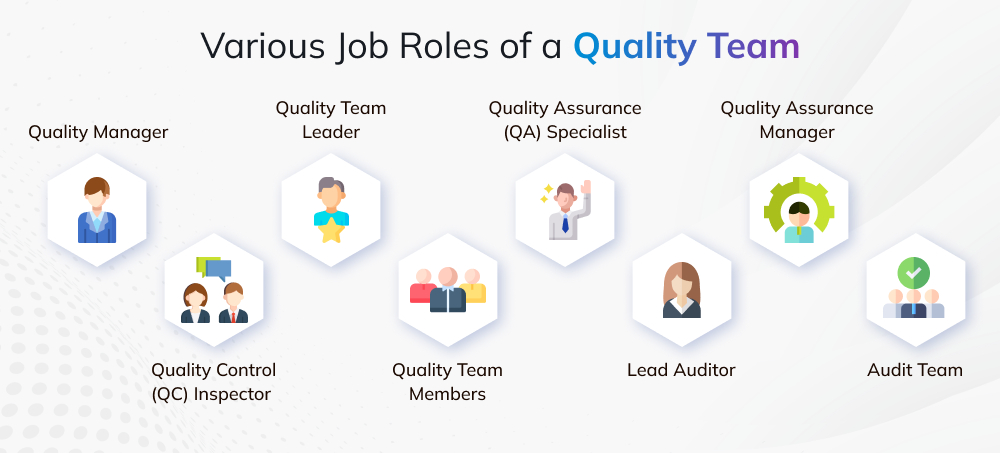
Quality isn’t just an inspection step; it’s a business strategy.
A recent ASQ study estimates that the cost of poor quality can reach 15–20% of a company’s annual revenue. From recalls in automotive giants to compliance failures in the pharmaceutical industry, weak quality practices don’t just hurt operations; they erode customer trust and market share.
This is why defining quality management team roles and responsibilities is more critical than ever. Take the example of Toyota’s quality crisis in 2009: rapid recalls revealed gaps not only in engineering but also in how quality responsibilities were distributed across teams. In contrast, companies like Johnson & Johnson have built reputations on strong cross-functional quality teams that embed compliance and trust into every product they produce.
This guide examines the structure of a quality management team, its key roles and responsibilities, and the skills required of professionals.
Table of Contents:
- What is Quality Management
- Quality Management Team roles and responsibilities
- Various Job Roles of a Quality Team
- Essential Skills for Quality Management Teams
- Career Growth and Certifications in Quality Management
- Conclusion
What is Quality Management?
Quality management is a comprehensive approach focused on ensuring that an organization’s products or services consistently meet or exceed customer expectations. It encompasses all activities and tasks necessary to maintain a desired level of excellence, including determining a quality policy, creating and implementing quality planning and assurance, quality control, and quality improvement. Quality management is structured around four components:
- Quality Planning: Identifying which quality standards are relevant to the project and determining how to satisfy them.
- Quality Assurance: The systematic activities implemented within the quality system to provide confidence that a product or service will fulfill quality requirements.
- Quality Control: The operational techniques and activities used to fulfill quality requirements, including the monitoring and recording results to evaluate the performance.
- Quality Improvement: Ongoing efforts to enhance product quality, service quality, and process efficiency.
Quality management aims to ensure that all the organization’s stakeholders work collectively to change the company’s rules, products, services, and experience to deliver the long-term benefit that arises from client happiness.
Quality Management Team Roles and Responsibilities
A Quality Management Team (QMT) is essential in any organization aiming to deliver high-quality products or services. This team is responsible for implementing, maintaining, and improving quality management systems (QMS). Here are the quality team roles and responsibilities typically associated with:
- Developing Quality Policies and Objectives: Establish clear quality policies and set measurable quality objectives that align with the organization’s goals
- Implementing Quality Management Systems: Ensure that the QMS is effectively implemented across all departments and processes
- Conducting Training and Awareness Programs: Educate employees about quality standards, procedures, and their roles in maintaining quality
- Performing Audits and Inspections: Regularly conduct internal audits and inspections to ensure compliance with QMS
- Managing Non-Conformances: Identify, document, and take corrective actions for any non-conforming products or processes
- Facilitating Continuous Improvement: Promote a culture of continuous improvement by identifying areas for improvement and implementing changes
- Ensuring Regulatory Compliance: Stay up-to-date with industry regulations and ensure the organization’s compliance
- Communicating with Stakeholders: Maintain clear and effective communication with internal and external stakeholders regarding quality issues and improvements
- Reporting on Quality Performance: Provide regular reports on the performance of the QMS to top management and other stakeholders
- Customer Satisfaction: Ensure customer satisfaction by addressing complaints and incorporating customer feedback into quality improvement initiatives
Now, we have a brief overview of quality team roles and responsibilities. We will discuss the roles of a quality team.
Various Job Roles of a Quality Team
A Quality management team ensures that products and services meet specified standards and customer expectations. Here are various job roles typically found within a Quality Team: Below are the essential roles and responsibilities of the quality management team.
Quality Manager
The Quality Manager provides the strategic backbone of the quality function, ensuring that objectives align with business goals and regulatory requirements. They are accountable for translating leadership priorities into measurable quality outcomes while driving compliance with standards like ISO 9001.
- Define measurable targets such as defect reduction, customer complaint rates, and audit pass percentages, then monitor progress against them.
- Oversee the implementation of quality frameworks like ISO 9001, IATF 16949, or GMP to keep operations globally compliant.
- Conduct regular reviews with leadership and coordinate with external auditors to validate system effectiveness.
- Allocate budgets, tools, and staff to support training, technology adoption, and CAPA (Corrective and Preventive Action) programs.
Quality Control (QC) Inspector
The QC Inspector ensures products and services meet specifications before release. They function as the frontline defense against defective output.
- Use defined protocols and statistical sampling to evaluate product batches for compliance.
- Record deviations accurately, flag patterns, and provide evidence for root-cause analysis.
- Monitor process variation through control charts and identify risks early.
- Supply actionable findings that drive corrective and preventive action projects.
Case StudyIn the construction industry, rework is one of the largest hidden costs, often accounting for 5–15% of total project expenses. A report by O’Construction highlighted how structured quality control practices can drastically reduce these inefficiencies. What Changed:
Impact Achieved:
This case demonstrates how a proactive QC function doesn’t just fix mistakes but prevents them, protecting both margins and brand credibility. |
Quality Team Leader
Quality team leader responsible for managing the quality team, setting goals, and ensuring that quality objectives are met. The following are the responsibilities of a quality team leader:
- Provide direction and support to the quality team, ensuring alignment with organizational goals
- Coordinate activities across different quality functions, such as quality control, quality assurance, and quality improvement
- Monitor team performance, provide feedback, and implement improvement plans
- Address and resolve quality-related issues and escalate significant problems to senior management
- Facilitate communication within the team and with other departments to ensure a unified approach to quality management
Mastering quality function deployment is essential for a quality team leader. Choose a comprehensive QFD Training Course to enhance your leadership capabilities and ensure top-quality results.
Quality Team Members
Quality team members carry out specific tasks related to quality control, assurance, and improvement, supporting the overall quality management system. The following are the responsibilities of a quality team member:
- Conduct inspections and tests to ensure products or processes meet quality standards
- Collect and analyze quality data to identify trends and issues
- Maintain accurate records of inspections, tests, and quality issues
- Assist in the implementation of quality initiatives and improvements
- Participate in training programs to stay updated on quality standards and procedures
Quality Assurance (QA) Specialist
The QA Specialist safeguards processes by preventing errors before they occur. Their focus is on robust workflows, documentation, and system validation.
- Draft clear, compliant operating procedures and ensure they are regularly updated to reflect evolving standards.
- Perform routine internal reviews to spot vulnerabilities before they escalate into failures.
- Integrate preventive controls across suppliers, raw materials, and in-process activities.
- Analyze deviations and propose long-term fixes that improve system resilience.
Lead Auditor
The lead auditor is responsible for planning, conducting, and reporting on internal and external quality audits. The following are the responsibilities of a lead auditor:
- Develop audit plans, including scope, objectives, and criteria
- Lead audit teams in conducting audits, ensuring thorough examination of processes and compliance with standards
- Document and report audit findings, including non-conformances and areas for improvement
- Ensure that corrective actions are implemented and verified
- Train and mentor junior auditors and quality team members on audit processes and best practices
Prepare yourself for the challenges of a Lead Auditor role with Lean IT Foundation Certification Training. Gain the skills to implement lean practices and improve audit outcomes effectively.
Case PointAudit processes are often time-consuming, paper-heavy, and prone to oversight. A study by Ease.io showed how digital audit platforms transformed compliance management for manufacturing and healthcare companies. What Changed?
Impact Achieved:
|
Quality Assurance Manager
The Quality Assurance (QA) Manager oversees the quality assurance processes and ensures that products and services meet established quality standards. The following are the responsibilities of a QA manager:
- Develop, implement, and maintain the quality management system (QMS)
- Ensure compliance with industry standards, regulations, and customer requirements
- Identify opportunities for process improvement and lead initiatives to enhance quality
- Provide training on quality standards, procedures, and best practices to employees
- Report on QA activities, performance metrics, and improvements to senior management
Audit Team
The audit team conducts internal and external audits to assess compliance with quality management systems and standards. The following are the responsibilities of an audit team:
- Prepare for audits by reviewing relevant documentation and standards
- Perform audits, including interviews, document reviews, and process observations
- Record audit findings, including any non-conformances, observations, and areas for improvement
- Compile audit reports and present findings to management
- Work with relevant departments to develop and implement corrective actions based on audit findings
- Conduct follow-up audits to ensure that corrective actions have been implemented and are effective
Essential Skills for Quality Management Teams
Defining roles is only half the story. For a quality management team to deliver results, its members must bring a diverse mix of technical expertise, analytical ability, leadership presence, and knowledge of compliance. These skills not only prevent costly errors but also build the foundation for customer trust and long-term competitiveness.
Analytical & Problem-Solving Skills
At the heart of quality work lies the ability to analyze problems, identify root causes, and prevent recurrence. Tools like Pareto analysis, Ishikawa diagrams, and FMEA allow teams to move beyond surface fixes and tackle systemic issues. This structured approach is what enabled General Electric to save $10 billion in the first five years of adopting Six Sigma, demonstrating how disciplined problem-solving can transform efficiency and profitability.
Knowledge of Quality Management Tools
A well-functioning team must know how to use statistical and process tools that detect issues before they escalate. Techniques such as Statistical Process Control (SPC), capability studies, and control charts enable early intervention, rather than relying solely on end-product testing. By embedding these tools into daily routines, teams build resilience into processes rather than firefighting at the end.
Communication & Leadership
Quality professionals often find themselves influencing teams beyond their direct authority. They need to inspire cooperation across departments that may see quality controls as additional workload. Strong communication and leadership bridge this resistance, turning compliance into a shared commitment.
Compliance Knowledge
Finally, quality teams must understand the regulatory environment in which they operate. From ISO 9001 and IATF 16949 in manufacturing to GMP and FDA regulations in the pharmaceutical industry, compliance expertise is what keeps organizations audit-ready and penalty-free. The urgency is clear: the U.S. FDA issued over 2,000 Warning Letters in 2023, with the majority citing failures in CAPA processes and documentation practices. Teams that stay ahead of such requirements not only avoid fines but also protect their reputation in highly competitive markets.
Career Growth and Certifications in Quality Management
Career advancement in quality management depends on building practical expertise and validating it with globally recognized certifications.
Lean Six Sigma Certifications (Yellow, Green & Black Belt)
Lean Six Sigma remains the gold standard for process improvement and defect reduction.
- The Lean Six Sigma Yellow Belt equips professionals with foundational skills to support projects.
- Lean Six Sigma Green Belt builds data-driven problem-solving skills for mid-level managers.
- Lean Six Sigma Black Belt enables leaders to drive large-scale organizational transformations.
ISO 9001 Lead Auditor & Awareness Training
ISO 9001 remains the most widely implemented QMS standard worldwide. Invensis offers ISO 9001 Lead Auditor Training, preparing professionals to manage and conduct audits, and ISO 9001 Awareness Training, ideal for staff needing foundational knowledge. These certifications validate expertise in compliance auditing and QMS implementation.
Specialized Quality Courses
Beyond Six Sigma and ISO, Invensis Learning provides a wide portfolio of niche quality training to meet industry-specific needs:
- 7 QC Tools Training: Equips teams with practical problem-solving frameworks.
- Kaizen & Poka Yoke Training: Focuses on continuous improvement and error-proofing.
- Root Cause Analysis (RCA) Training: Sharpens analytical skills for systemic problem resolution.
- Minitab Essentials & Design for Six Sigma: Develops statistical and process design expertise.
Conclusion
Quality is no longer just about inspection; it is about building a culture of excellence that touches every part of the organization. A well-structured quality management team ensures that responsibilities are clear, processes are reliable, and accountability is shared at every level.
From managers who set the vision to auditors, inspectors, and frontline staff who safeguard execution, each role contributes to maintaining standards and protecting trust. When these roles are aligned, quality becomes more than compliance; it becomes a driver of customer confidence and sustainable growth.
















